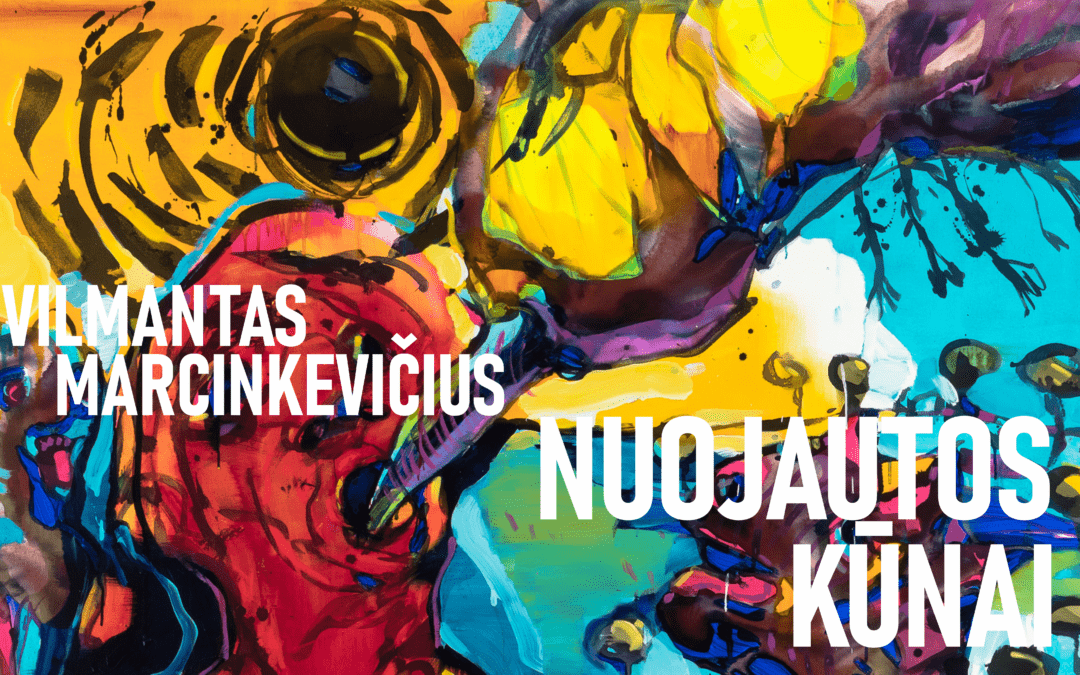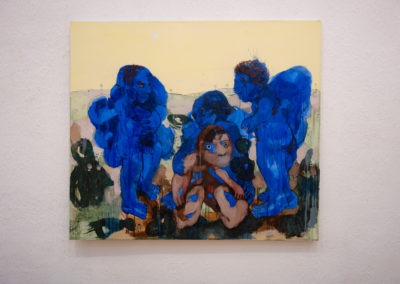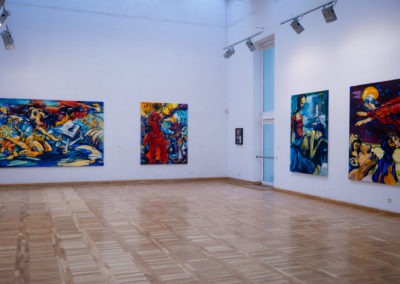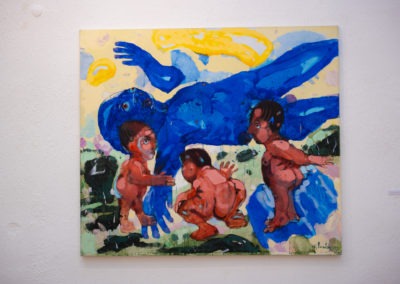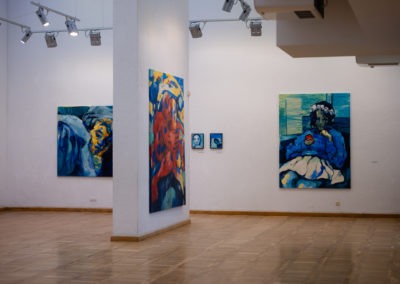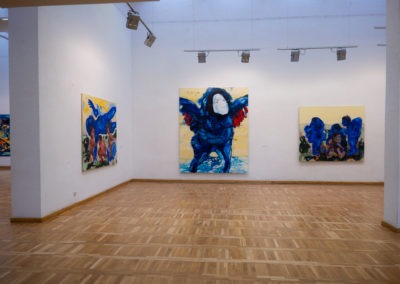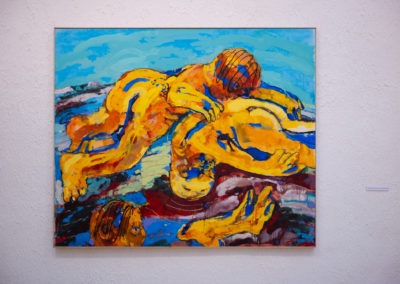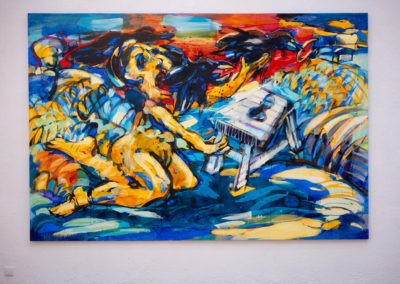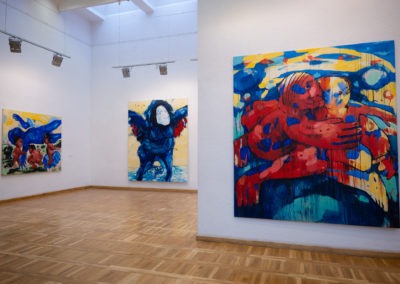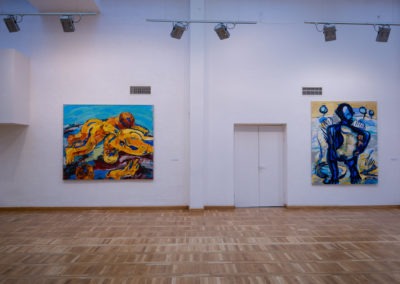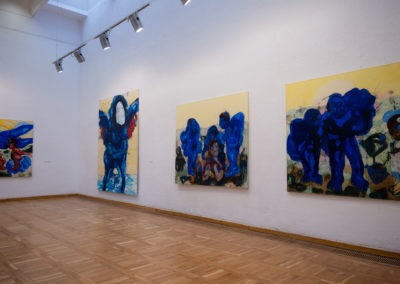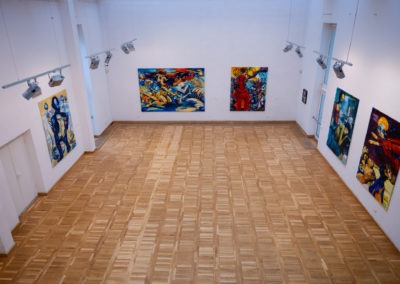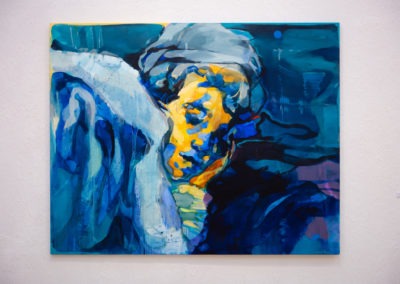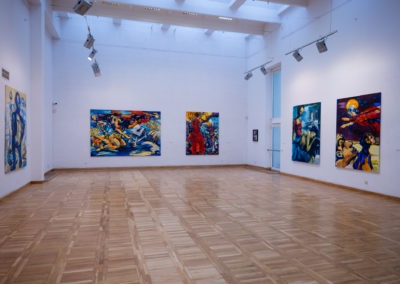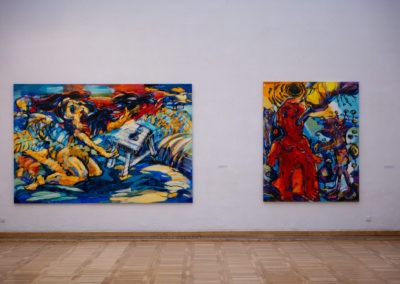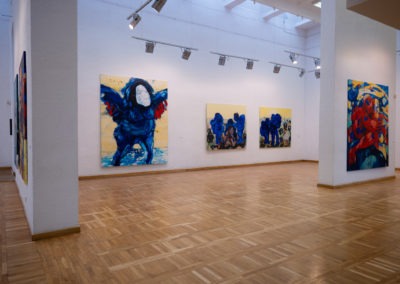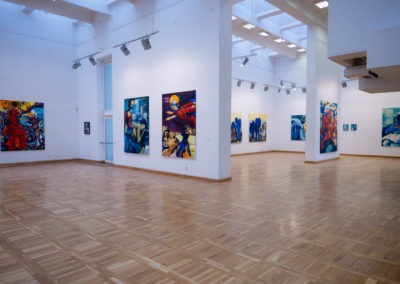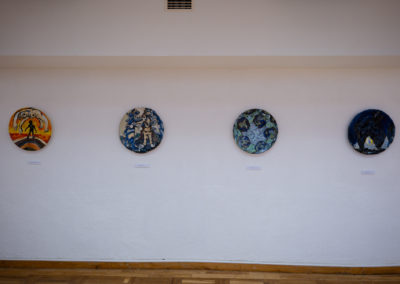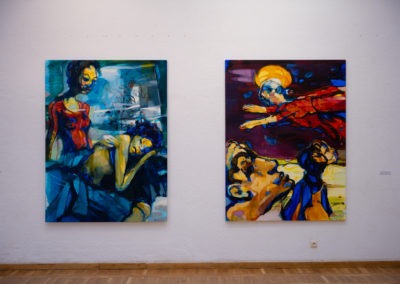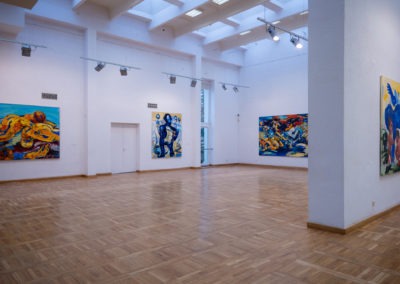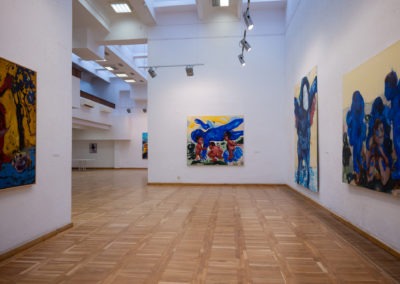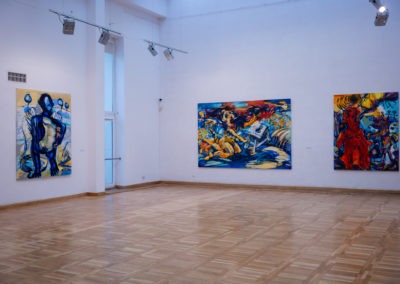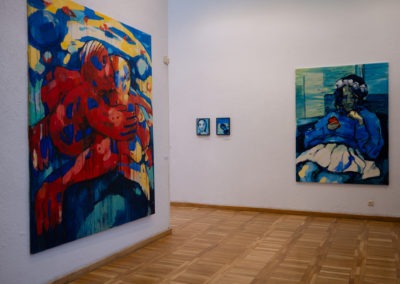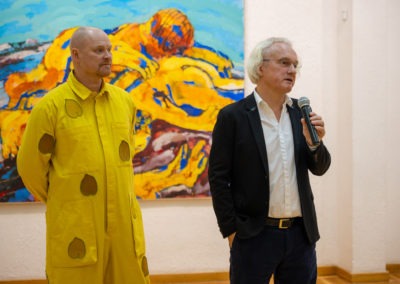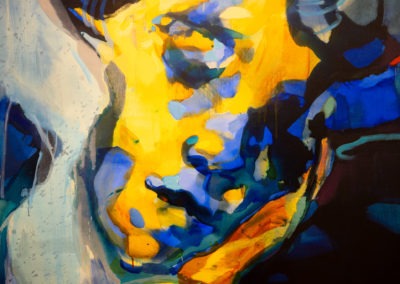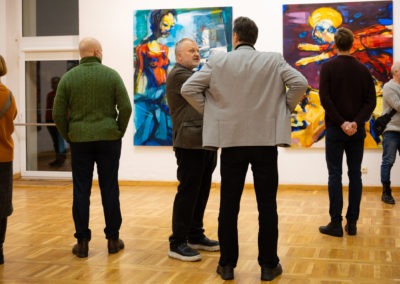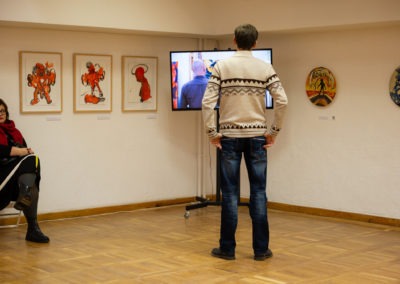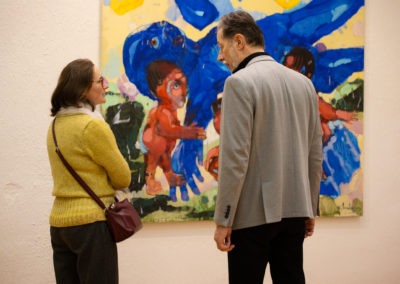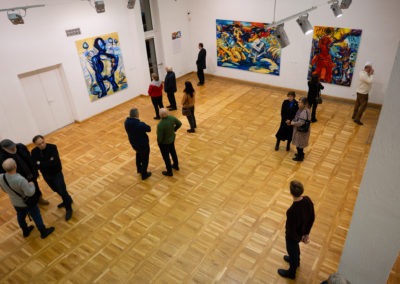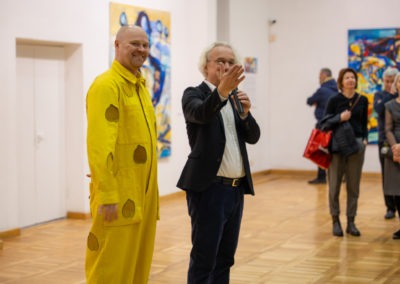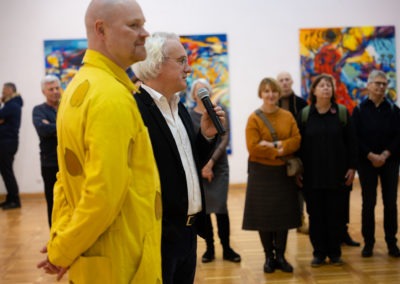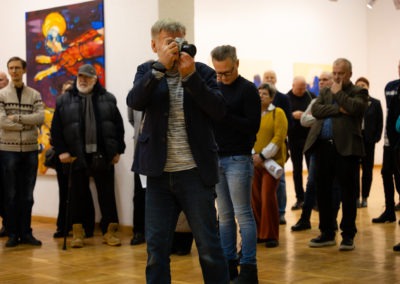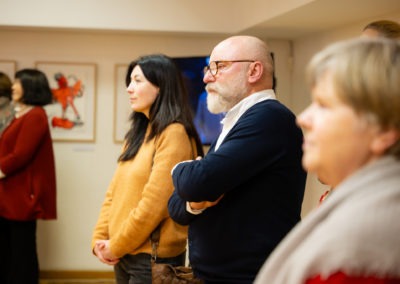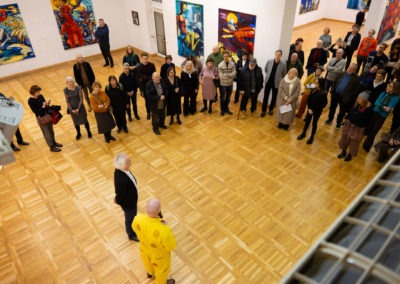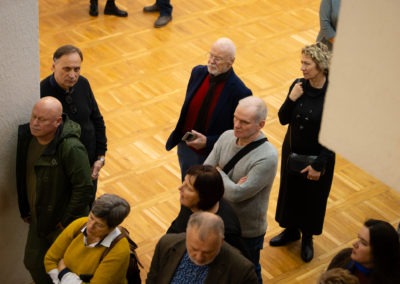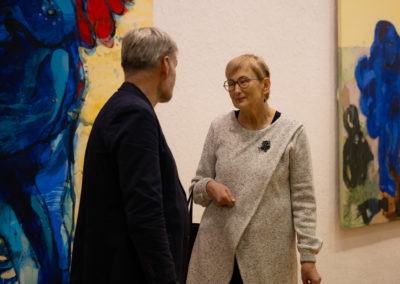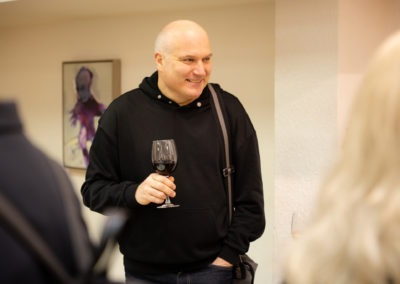2023 m. gruodžio 21 d., ketvirtadienį, 17.30 val. Šiaulių dailės galerijoje atidaroma menininko Vilmanto Marcinkevičiaus tapybos darbų paroda „Nuojautos kūnai“.
Paroda veiks iki 2024 m. sausio 20 d.
NUOJAUTOS KŪNAI
Priminti ir pasakoti apie tai, kad Vilmantas Marcinkevičius priklauso ne tokiai ir didelei neoekspresionistinės dailės kūrėjų grupei bei yra vienas iš ryškiausių jų atstovų, ar tai, jog jau studijuodamas išsiskyrė savo veržlia, koloristinį temperamentą vargiai sutvardančia tapybos maniera, rodosi nereikšminga – visą tai jau seniai surašyta straipsniuose, knygose ir anotacijose. Kaip ir linksniuoti Danijos karališkosios šeimos portretavimą, Hedeager bažnyčios interjero detalių kūrimą ar tai, kad menininkas yra vieno svarbiausių Baltijos tapybos konkursų – „Jaunojo tapytojo prizas“ – organizatorius.
Kalbantieji apie šio dailininko tapybą neretai pirmiau postringauja apie spalvas, dažo skaidrumą bei meistrišką jų perliejimą, ir daug rečiau pirma pasigirsta mintys apie tai ką matome už spalvų – naratyvą, istoriją. Tad būtent čia ir sutelkime dėmesį. Dar studijų metais neieškodamas korifėjų bei aklai nesivaikydamas autoritetų, menininkas neaplenkė nė vienos labiau kontraversiškos idėjos. Biblija, legendos, mitai, viešnamių darbuotojos, karo prievartos aukos – rodos, kuo tema labiau angažuota visuomenės, kuo ji nepatrauklesnė klausytojams, tuo ryškiau, sodriau ir intensyviau ji interpretuojama, bei pateikiama publikai. Štai 1999 m. menotyrininkė N. Adamonytė bandydama užčiuopti menininko vizualinio naratyvo ašį, itin taikliai pasakė, kad Vilmanto „kūriniai ironizuoja santūrų ir skausmingą lietuvišką mentalitetą, įvilkdami neigiamus krūvius į optimistišką, sąmojingą formą, atpalaiduodami žiūrovą savo gruboka, necenzūruota leksika“. Nesutikti būtų sunku, tai pamatysite ir šiandien.
Čia, prieš Jus – vieni naujausių menininko darbų. Gaiviai nutapytuose neoekspresionistiškai realistiniuose dailininko kūriniuose skirtumas tarp matymo ir vaizduotės nėra visai aiškus, nes regimi pasakojimai, jų interpretacinės nuotrupos neretai sumontuotos į besiūlę, tikrovėje neįmanomą situaciją ar kompoziciją. Drobėse Vilmantas konstruoja neregėtą, kartais mįslingą bei kupiną asmeniškumų pasaulį, ir tokiu būdu reflektuoja unikalų kūrybinį suvokimą bei intymumo jauseną. Nesvarbu ką manote – susigūžusį iš baimės berniuką, nenaudojamą karo uniformą ar purpurinį kūną besusiliejantį su kauke – visa tai menininko pasaulio nuotrupos, kritinių psichinių būsenų interpretacija. Kiekvienas šioje salėje eksponuojamas tapybos darbas esti keletos kompozicinių ir prasminių matymo modelių, kurie atspindi vienokį ar kitokį tuo metu menininkui svarbų, aktualų santykį su išoriniu pasauliu ar su vidiniais ego dvasiniais išgyvenimais, transcendentine filosofine individo patirtimi.
Šaukiančios, ryškios spalvos šiuose darbuose veikia lyg įspėjimas apie tai kas gali nutikti, o gal jau ir nutiko. Tačiau, visai kaip gerai surežisuotame magijos pasirodyme liekame apkvailinti, nes pasitelkdamas spalvas, lyg sirenos garsą, Vilmantas užliūliuoja žiūrovą kolorito melodijoje taip klaidindamas žvilgsnį bei atitraukdamas dėmesį nuo šiukštaus, kartais net tvaikiai nemalonaus sustabdytos istorijos momento. Arba kartais atvirkščiai, siekdamas suintensyvinti kūrinio ir pateikiamo naratyvo patyrimą.
Bežvelgiant į šios parodos visumą nuojauta, lyg tuoj, čia pat, kažkas nutiks, neapleidžia. Mistifikuoti moters įvaizdžiai veikia lyg pasakose ir mituose išnyrantys įspėjimai apie negandą. Kūnas atlieka pranašystės bei intuicijos lauko funkciją. Nutapytosios ryja paukščius, šaukia ant prieš save esančių, siurbia į save visas pasaulio istorijas arba, prieš pat mus, tampa paukščiais. Šios, rodos akyse besitveriančios, figūros ir istorijos, kuriose moterys įklimpusios tarsi inkliuzai, tai – baimių, košmarų emocinės tąsos, kurios sukelia tokį patį sapnišką, jei ne paveikesnį įtampos ir skausmo pojūtį.
Marcinkevičiaus darbai, visai kaip gyvenimai ir lietuviškas pavasaris, yra daugiadugniai. Jie neprašydami įveiklina vaizduotę ir pritraukdami dėmesį pasakoja kažkada kažkur girdėtas, tačiau pamirštas, į užkaborius nustumtas istorijas. Kūryba šiam dailininkui – veikiau takai į tapybos pasakojimą, o ne į jos metmenis.
Aistė M. Grajauskaitė
2023 December 21, Thursday, 5:30 p.m. the exhibition „Bodies of foreboding” by the artist Vilmantas Marcinkevičius opens in the Šiauliai Art Gallery.
The exhibition will run until 2024 January 20.
FOREBODING BODIES
Reminding and telling about the fact that Vilmantas Marcinkevičius belongs to a not so large group of creators of neo-expressionist art and is one of their most prominent representatives, or the fact that he already distinguished himself during his studies with his energetic, coloristic temperament, hardly restraining his painting style, seems insignificant – all of this has already happened a long time ago. compiled in articles, books and annotations. Like the portraiture of the Danish royal family, the creation of interior details of the Hedeager church, or the fact that the artist is the organizer of one of the most important Baltic painting competitions – the Young Painter’s Prize.
Those who talk about the painting of this artist often first postulate about the colors, the transparency of the paint and their skillful transfer, and much less often the first thoughts are heard about what we see behind the colors – the narrative, the story. So let’s focus on this. While not looking for luminaries and blindly chasing authorities even during his studies, the artist did not bypass any more controversial ideas. The Bible, legends, myths, brothel workers, victims of war rape – it appears that the more engaged the public is, the less attractive it is to listeners, the brighter, richer and more intensively it is interpreted and presented to the audience. Here is 1999. art critic N. Adamonytė, trying to grasp the axis of the artist’s visual narrative, very aptly said that Vilmanta’s „works ironize the restrained and painful Lithuanian mentality, dragging negative charges into an optimistic, witty form, relaxing the viewer with their rough, uncensored vocabulary”. It would be hard to disagree, as you will see today.
Here, in front of you – some of the latest works of the artist. In the freshly painted neo-expressionist realistic works of the artist, the difference between vision and imagination is not entirely clear, as stories are visible, their interpretive fragments are often assembled into a seamless situation or composition that is impossible in reality. In the canvases, Vilmantas constructs an unseen, sometimes enigmatic and full of personalities world, and in this way reflects a unique creative perception and a sense of intimacy. It doesn’t matter what you think – a boy cowering in fear, an unused military uniform or a purple body merging with a mask – all this is a fragment of the artist’s world, an interpretation of critical mental states. Each work of painting exhibited in this hall is a series of compositional and meaningful models of vision that reflect one or another important, relevant relationship for the artist at that time with the external world or with the inner spiritual experiences of the ego, the transcendental philosophical experience of the individual.
The screaming, bright colors in these works act as a warning about what might happen, or maybe already happened. However, just like in a well-staged magic performance, we remain fooled, because using colors, like the sound of a siren, Vilmantas lulls the viewer into a colorful melody, thus misleading the gaze and distracting attention from the gross, sometimes even steamy unpleasant moment of the stopped story. Or sometimes vice versa, in order to intensify the experience of the work and the narrative presented.
Looking at this exhibition as a whole, there is a feeling that something is about to happen, right here. Mystified images of women act as warnings of doom emerging from fairy tales and myths. The body performs the function of the field of prophecy and intuition. The painted ones swallow birds, shout at those in front of them, absorb all the stories of the world or, right before us, become birds. These lingering figures and stories, in which women are stuck as inclusions, are emotional continuations of fears and nightmares, which cause an equally dreamlike, if not more impactful, sense of tension and pain.
Marcinkevičius’s works, just like his life and the Lithuanian spring, are multi-faceted. Without asking, they engage the imagination and, attracting attention, they tell stories that were once heard somewhere, but forgotten, pushed into the recesses. For this artist, work is rather a path to the narrative of the painting, rather than its outline.
Aistė M. Grajauskaitė

